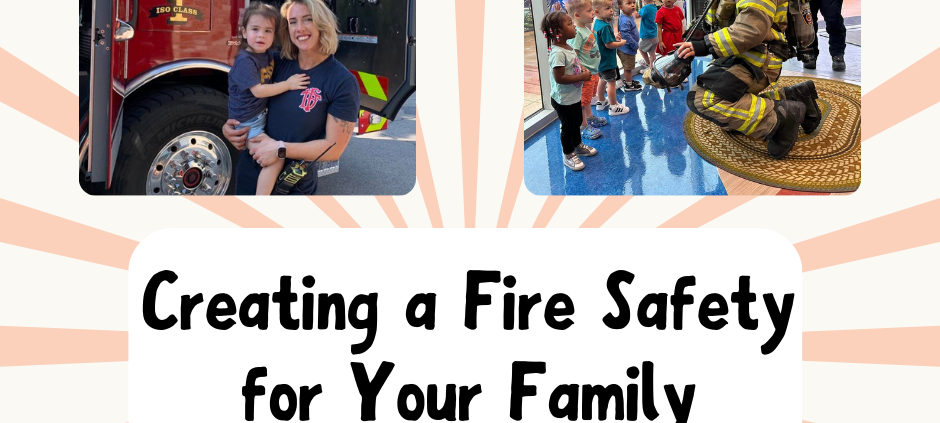Creating a Fire Safety Plan for Your Family
At Imagine Early Education and Childcare, the safety and well-being of your child are always our top priority. While we work diligently to ensure that our centers are safe and secure, we also believe it’s important for families to have a safety plan at home—especially when it comes to fire safety.
A fire can happen unexpectedly, and having a well-thought-out fire safety plan can make all the difference in keeping your family safe. Here, we’ll guide you through the steps of creating a fire safety plan and offer tips on how to involve your children in a way that empowers them to act confidently in case of an emergency.
Why Your Family Needs a Fire Safety Plan
Fire emergencies can be stressful and chaotic, but preparation helps reduce the risk of injury or panic. Having a fire safety plan ensures that everyone in your household knows exactly what to do and where to go if a fire breaks out. By practicing your plan regularly, you help your family stay calm and act quickly in an emergency.
Children, in particular, may feel scared or unsure in the face of a fire, so it’s important to include them in creating and practicing the plan. At Imagine Early Education and Childcare, we teach children basic safety measures in a fun and engaging way, and you can do the same at home!
Start by Drawing a Map of Your Home
The first step in creating a fire safety plan is to draw a map of your home. Include all doors, windows, and escape routes in each room. Mark at least two exits from every room, as one exit may be blocked by fire. For example, the main door could be one exit, and a window could serve as an alternate.
Make sure your children are familiar with the map and understand where all the exits are located. You can even make it a fun activity by asking your child to help color in the escape routes.
Choose a Family Meeting Spot
In your fire safety plan, designate a meeting spot outside your home where everyone should go once they’ve escaped the fire. This could be a tree, a neighbor’s house, or a mailbox. The meeting spot should be far enough away from the house to avoid danger but close enough that young children can get there quickly.
Emphasize to your child that once they’ve reached the meeting spot, they should stay there and wait for the rest of the family or emergency responders. Teach them not to go back inside the house for any reason.
Test and Practice Your Escape Plan
Once you’ve mapped out your escape routes and chosen a meeting spot, it’s time to practice! Conduct regular fire drills with your family so that everyone knows exactly what to do. Time the drill to see how quickly everyone can get out, and practice different scenarios, such as using alternate exits if one is blocked.
At Imagine Early Education and Childcare, we regularly practice fire drills with our students so they understand the process and feel comfortable following safety protocols. Practicing at home reinforces these skills and gives your child the confidence they need in a real situation.
Teach Stop, Drop, and Roll
In addition to practicing the escape plan, make sure your children know the basics of fire safety. One of the most important lessons is “Stop, Drop, and Roll.” If their clothes catch on fire, they should stop immediately, drop to the ground, cover their face, and roll to extinguish the flames.
Practice this drill with your child so they remember what to do if they ever find themselves in this situation. You can even make it a game by calling out “Stop, Drop, and Roll” randomly during playtime to see how quickly they can respond!
Check Smoke Alarms Regularly
Working smoke alarms are your family’s first line of defense against fire. Ensure that you have smoke alarms installed on every level of your home, inside bedrooms, and near sleeping areas. Test the alarms monthly to make sure they are functioning properly, and replace the batteries at least once a year.
Involve your child in the process by letting them hear what the smoke alarm sounds like. This helps them recognize the alarm and understand that when they hear it, they need to follow the fire escape plan immediately.
Teach Kids How to Call 911
It’s important for children to know how to call 911 in case of an emergency. Teach them how to use a phone to dial 911 and explain that they should only do so if there is a real emergency. Help them memorize their address so they can provide it to the emergency operator.
You can practice this skill with your child by role-playing different scenarios, such as pretending to call 911 and giving the operator your home address. These simple exercises can make a big difference in a real-life situation.
Fire Safety Is an Ongoing Conversation
Creating a fire safety plan isn’t a one-time task—it’s something that should be revisited regularly. As your family grows or if you move to a new home, update your plan and practice it again. Ongoing conversations about safety will help your child feel prepared, calm, and ready to act if a fire ever occurs.
At Imagine Early Education and Childcare, we are committed to keeping your children safe, both in our centers and at home. By developing a family fire safety plan and practicing it together, you ensure that your family is well-prepared to face any emergency. Let’s work together to protect what matters most!



